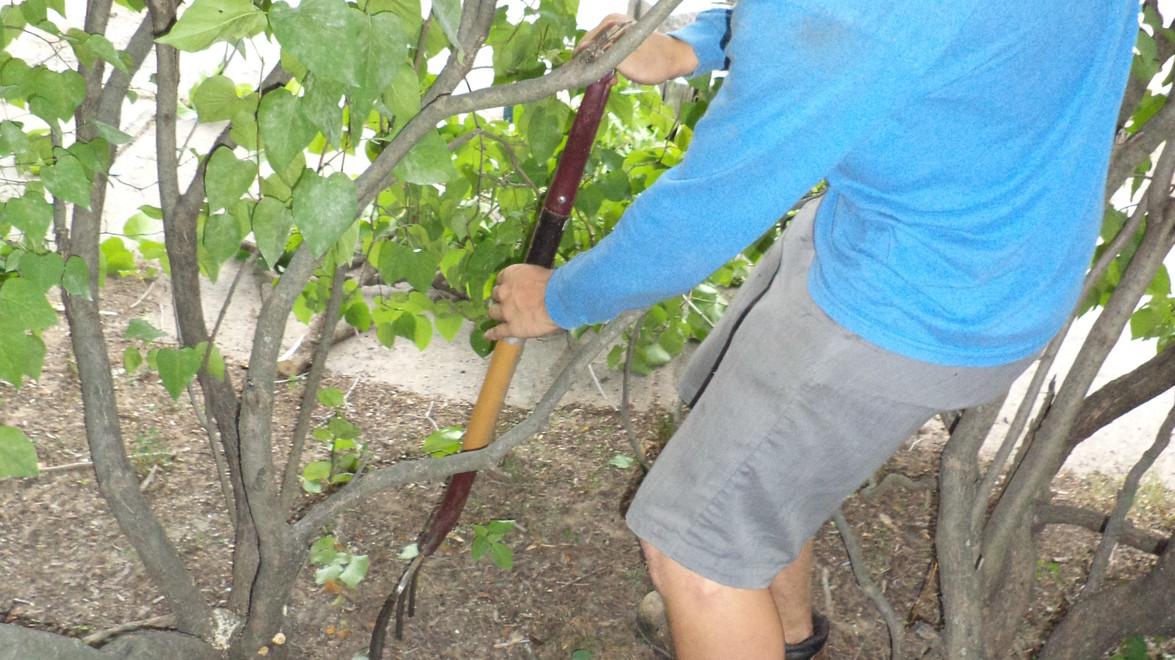
It is hard to imagine a Canadian garden without at least one shrub lilac (*Syringa vulgaris* sp.). These shrubs are a common sight on country roads, towering alongside houses and barns or used as focal points and hedges in urban areas. One thing that is not commonly known about lilacs is how to properly prune them.
Gardeners plant new lilacs with no pruning instruction which evolves to facing an established lilac that is very tall having thick stalks with foliage and flowers all growing on the topside of the plant. This sight can feel overwhelming and many gardeners stand with their pruners in hand not even knowing where to begin. Let this blog post serve as a guide on how to establish a pruning program to improve and maintain you’re lilacs!
### Top Reasons Why it is Beneficial to Prune Lilacs:
1. Height Control – keeping lilacs pruned to just over head height (6-9’) will ensure that they are within perfect reach to maintain giving the best shape and the perfect height to smell the flowers!
2. Flower Quality – Once the diameter of a stem becomes thicker than 2 ½”, the size and the amount of flower clusters will lessen as well as the intensity of the flower colour. Younger stems 1-2 ½” will produce the best blooms.
3. Keep Them Young – By keeping only 7-12 suckers (stems) at a time and pruning out older stems every year, will keep the shrub ‘youthful’ by promoting vigor, consistent new growth with the best flower quality.
### When to Prune & How Much?
The most optimal time to prune is in late winter before the buds start to grow (when the shrub is still dormant). Pruning at this time of year allows the plant to best utilize energy stored within its root system because when it comes out of dormancy it will be stimulated to grow new suckers. However, most do not prune this time of year because since lilacs bloom from growth formed the previous year, blooms will be sacrificed if stems are pruned out. Also, it is pretty cold outside!
The second best time to prune is immediately after bloom. This will give the lilac enough time to form new growth the remainder of the season (for blooms next year) and allows you to dead-head spent blooms at the same time.
As previously stated, the amount of suckers you want to keep at any given time is from 7-12. If you are new to pruning and want to start a routine here is what to keep in mind when you begin (look through the pictures above for visual aids):
– Only prune out 30% of the shrub at a time – this allows the shrub to comfortably produce new growth without severely affecting energy reserves. Any more than this could stunt the growth of the shrub and delay bloom. Extreme cases can result in death.
– Remove dead and weak wood
– Remove branches that are rubbing against each other – if you don’t have very many stems to choose from, only remove one of the two branches.
– Remove cross branches – this will keep good form.
– Prune lateral branches to maintain height – shorten branches just above a bud or a lateral branch – ensure that whatever amount you decide to prune out, that there is enough leaves left to produce energy to heal the wound.
– Thin out the shrub so that there is even, consistent growth that is spread out.
– Rotate as you prune – remember to always keep moving around the shrub as you prune, this will help even out gaps made from pruning out large branches.
– DO NOT LEAVE STUBS – if you are pruning out a stem make sure to prune it flush to the ground. This will also help the lilac heal faster and produce new growth faster if it realizes that the stem has been completely removed.
### To Prune or Not to Prune?
For most gardeners who have not pruned before, as you begin the rejuvenation process, doubts begin to surface if you’re not pruning enough or too much? The best suggestion is to follow your instinct and see how the shrub responds. Of course each shrub is different and pruning depends on the plant’s response. A month or two after pruning if you notice that significant growth has appeared, than it is a fair judgement to say if you pruned it ‘lightly’, the plant will respond to harder pruning the next time. Lilacs are pretty tough shrubs, most will be surprised at how well they respond to pruning.
### No Suckers Appearing? Don’t Worry…
A problem that occurs with some older lilacs is that there may only be 1 or 2 main stems that make up the entire plant. These stems are usually thicker than 2 ½” and even though you may have pruned some lateral branches to stimulate new growth there are no suckers appearing. If this sounds familiar one method you may want to try is using a garden fork to stab the roots after pruning. This damage to the roots will help to stimulate suckers to grow. If this has been tried for a couple of years without response, make sure that your lilac has enough sun and irrigation during the hot and dry months and try applying fertilizer. The worst case scenario is either you keep the lilac the way it is or if it is not responding replace the plant with a new one.
### Irrigation & Fertilization
A lilac will grow and respond quickly to pruning if it is growing in optimal conditions which is full sun in porous, well-drained soil. They will also grow in moist soils as long as it is not saturated year round.
If the soil on site gets dry, it is important that the lilac receives enough water each week, especially right after pruning occurs. Lilacs grow best if they are growing in cultivated soil that is free of grass and weeds with a mulch ring around the base. Mulch will also help preserve the moisture in the soil.
Fertilizer can be applied in the spring or fall, for organic gardeners apply a layer of compost or manure around the root zone of the lilac. For gardeners looking for a regular fertilizer choose a standard shrub fertilizer. If lilacs are newly transplanted and or not blooming well, try a high phosphate fertilizer such as a 0-20-0 or a 5-45-15.
### Patience is a Virtue
Just a reminder that if this is your first year taming a large, overgrown lilac it will take an average of 3 years to achieve the optimal shape and size. This may seem like a long time, however the end result will reward you with a happy and healthy shrub covered in fragrant, vibrant blooms.
### Special Thanks
During my time at the Royal Botanical Gardens in Burlington, I learned the art of pruning lilacs from the previous curator of the Katie Osborne Lilac Collection, Charles Holetich. This was a memorable training session from a very passionate lilac enthusiast. As a gardener and lover of lilacs I feel compelled to share this knowledge in hopes that you too will also gain a greater appreciation for lilacs as I have. Thanks again Charles!
We always love to hear from our readers, if you have any questions, comments or pictures of your lilacs, please feel free to email me, and we will share them on the blog.
I look forward to hearing from you,
Andrea
aweddum@gelderman.com
*Pictures and post contributed by
Andrea Weddum, Landscape Designer*
*Cover photo courtesy of **Paul Jarsky**. Originally published on [mycityisagarden.com.](http://mycityisagarden.com/2013/05/22/the-katie-osborne-lilac-collection-rbg-hamilton-canada/)*








